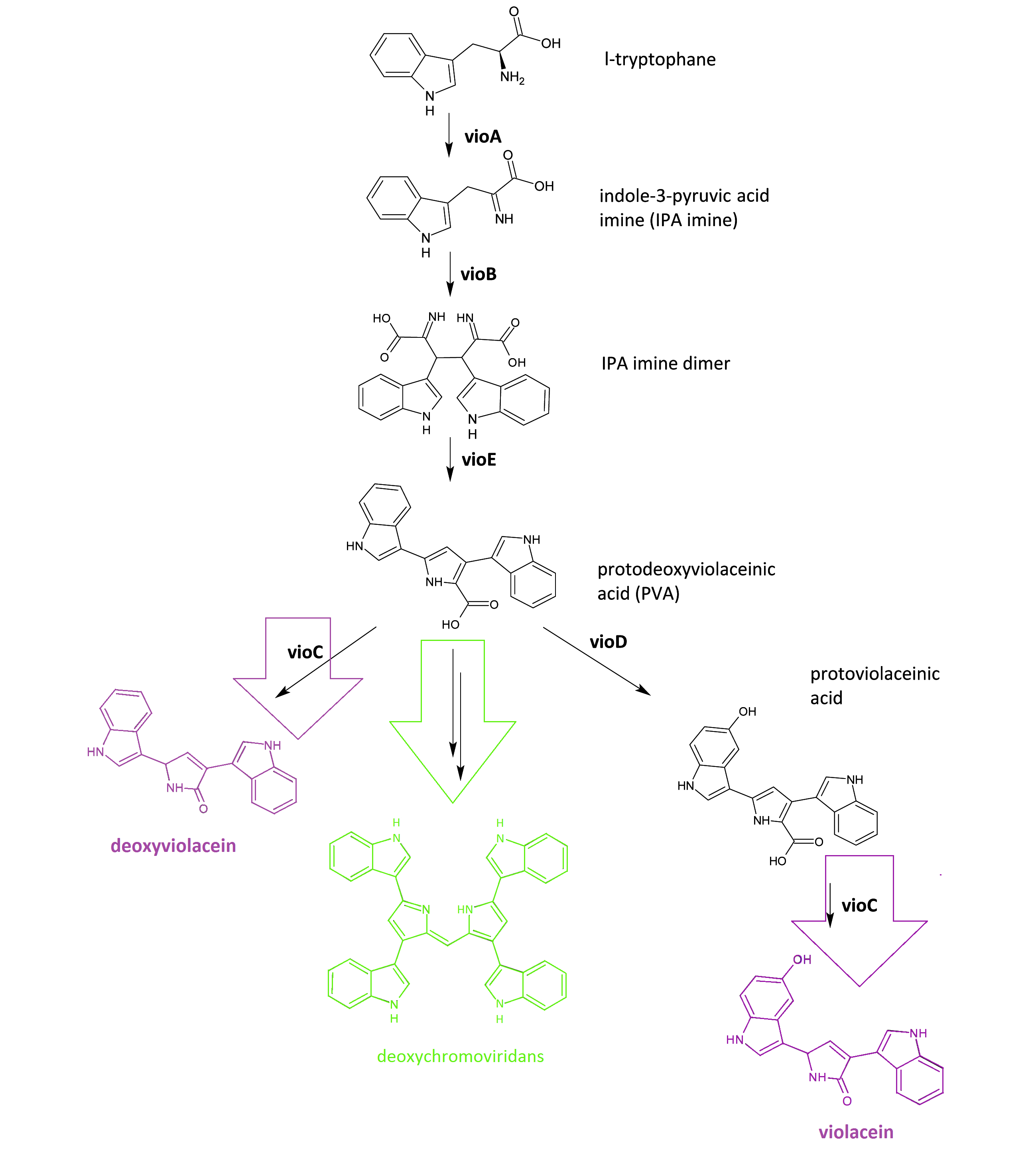Difference between revisions of "Part:BBa K771206"
Zhiantinglan (Talk | contribs) (→Violacein biosynthetic pathway) |
Zhiantinglan (Talk | contribs) (→Violacein biosynthetic pathway) |
||
| Line 8: | Line 8: | ||
Violacein is a violet pigment produced by several bacteria through pathway of 5 related genes, vioA, vioB, vioC, vioD and vioE. It was initially discovered in Chromobacterium violaceum. This metabolite of tryptophan has such special applications as antibacterial, anti-trypanocidal, anti-ulcerogenic, and anticancer drugs. | Violacein is a violet pigment produced by several bacteria through pathway of 5 related genes, vioA, vioB, vioC, vioD and vioE. It was initially discovered in Chromobacterium violaceum. This metabolite of tryptophan has such special applications as antibacterial, anti-trypanocidal, anti-ulcerogenic, and anticancer drugs. | ||
| − | [[Image: | + | [[Image:12SJTU VioPathway.png|600px|center]] |
The violacein biosynthetic pathway includes 5 key enzymes which work in conjunction. VioA, a flavoenzyme and VioB, a heme protein, work together to oxidize and dimerize tryptophen into IPA imine dimer. Then vioE induces a indole rearrangement,producing prodeoxyviolacein acid, also known as PVA. | The violacein biosynthetic pathway includes 5 key enzymes which work in conjunction. VioA, a flavoenzyme and VioB, a heme protein, work together to oxidize and dimerize tryptophen into IPA imine dimer. Then vioE induces a indole rearrangement,producing prodeoxyviolacein acid, also known as PVA. | ||
Revision as of 05:32, 28 September 2012
Vio D with Membrane Anchor 6
This part is composed with two parts, the Membrane Anchor 6 and Violacein synthetic pathway enzyme vioD. The enzyme can be aggregated with other membrane anchors, composing the Membrane Magic system. For more information, please visit [http://2012.igem.org/Team:SJTU-BioX-Shanghai 2012 SJTU-BioX-Shanghai wiki]
Violacein biosynthetic pathway
Violacein is a violet pigment produced by several bacteria through pathway of 5 related genes, vioA, vioB, vioC, vioD and vioE. It was initially discovered in Chromobacterium violaceum. This metabolite of tryptophan has such special applications as antibacterial, anti-trypanocidal, anti-ulcerogenic, and anticancer drugs.
The violacein biosynthetic pathway includes 5 key enzymes which work in conjunction. VioA, a flavoenzyme and VioB, a heme protein, work together to oxidize and dimerize tryptophen into IPA imine dimer. Then vioE induces a indole rearrangement,producing prodeoxyviolacein acid, also known as PVA.
VioD that we insert in this part belongs to the last 2 enzymes in this pathway that produce the final main product,violacein.It is a flavin-dependent oxygenase that hydroxylates 5-position indole ring, then the other 2-position indole ring is processed by VioC(see BBa_K771205) to create the oxindole,thus violacein is synthesized.
Sequence and Features
- 10INCOMPATIBLE WITH RFC[10]Illegal EcoRI site found at 1465
Illegal XbaI site found at 1477 - 12INCOMPATIBLE WITH RFC[12]Illegal EcoRI site found at 1465
- 21INCOMPATIBLE WITH RFC[21]Illegal EcoRI site found at 1465
- 23INCOMPATIBLE WITH RFC[23]Illegal EcoRI site found at 1465
Illegal XbaI site found at 1477 - 25INCOMPATIBLE WITH RFC[25]Illegal EcoRI site found at 1465
Illegal XbaI site found at 1477
Illegal AgeI site found at 494
Illegal AgeI site found at 1339 - 1000INCOMPATIBLE WITH RFC[1000]Illegal BsaI site found at 960
Illegal SapI.rc site found at 2458
Illegal SapI.rc site found at 2533

